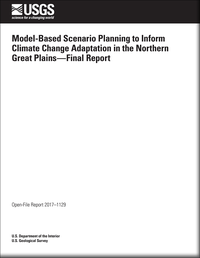Model-based scenario planning to inform climate change adaptation in the Northern Great Plains—Final report
Links
- Document: Report (2.63 MB pdf)
- Data Release: USGS data release - State-and-transition simulation model of rangeland vegetation in southwest South Dakota (1969–2050)
- Download citation as: RIS | Dublin Core
Public Summary
We worked with managers in two focal areas to plan for the uncertain future by integrating quantitative climate change scenarios and simulation modeling into scenario planning exercises.
In our central North Dakota focal area, centered on Knife River Indian Villages National Historic Site, managers are concerned about how changes in flood severity and growing conditions for native and invasive plants may affect archaeological resources and cultural landscapes associated with the Knife and Missouri Rivers. Climate projections and hydrological modeling based on those projections indicate plausible changes in spring and summer soil moisture ranging from a 7 percent decrease to a 13 percent increase and maximum winter snowpack (important for spring flooding) changes ranging from a 13 percent decrease to a 47 percent increase. Facilitated discussions among managers and scientists exploring the implications of these different climate scenarios for resource management revealed potential conflicts between protecting archeological sites and fostering riparian cottonwood forests. The discussions also indicated the need to prioritize archeological sites for excavation or protection and culturally important plant species for intensive management attention.
In our southwestern South Dakota focal area, centered on Badlands National Park, managers are concerned about how changing climate will affect vegetation production, wildlife populations, and erosion of fossils, archeological artifacts, and roads. Climate scenarios explored by managers and scientists in this focal area ranged from a 13 percent decrease to a 33 percent increase in spring precipitation, which is critical to plant growth in the northern Great Plains region, and a slight decrease to a near doubling of intense rain events. Facilitated discussions in this focal area concluded that greater effort should be put into preparing for emergency protection, excavation, and preservation of exposed fossils or artifacts and revealed substantial opportunities for different agencies to learn from each other and cooperate on common management goals. Follow up quantitative simulation modeling of grassland dynamics helped quantify the degree of change expected in vegetation production under the wide range of climate scenarios and suggested that (a) low grazing rates could be adversely affecting vegetation composition in the national park and (b) understanding of the management practices needed to maintain desired vegetation conditions is incomplete.
Suggested Citation
Symstad, A.J., Miller, B.W., Friedman, J.M., Fisichelli, N.A., Ray, A.J., Rowland, Erika, and Schuurman, G.W., 2017, Model-based scenario planning to inform climate change adaptation in the Northern Great Plains—Final report: U.S. Geological Survey Open-File Report 2017–1129, 22 p., https://doi.org/10.3133/ofr20171129.
ISSN: 2331-1258 (online)
Study Area
Table of Contents
- Acknowledgments
- 1. Public Summary
- 2. Project Summary
- 3. Report Body
- 4. References Cited
| Publication type | Report |
|---|---|
| Publication Subtype | USGS Numbered Series |
| Title | Model-based scenario planning to inform climate change adaptation in the Northern Great Plains—Final report |
| Series title | Open-File Report |
| Series number | 2017-1129 |
| DOI | 10.3133/ofr20171129 |
| Publication Date | December 18, 2017 |
| Year Published | 2017 |
| Language | English |
| Publisher | U.S. Geological Survey |
| Publisher location | Reston, VA |
| Contributing office(s) | Northern Prairie Wildlife Research Center |
| Description | Report: vii, 22 p.; Data Release |
| Country | United States |
| State | Montana, Nebraska, North Dakota, South Dakota, Wyoming |
| Online Only (Y/N) | Y |


